Watches that conquered the space
The history of space exploration by watches is documented. The first time meter, turned out to be in orbit, was made in the Soviet Union. That watch went developing the space on April 12, 1961, at the ship "Vostok 1". It was called "Shturmanskie", its hands showed 9 hours and 7 minutes by Moscow time at the moment of start, and it was on the wrist of the first Soviet cosmonaut Yuri Gagarin.
The first flight of Yuri Gagarin into space with the watch "Polet"
The watch and the person wearing it first appeared in the space not long ago - just a half-century ago. But the very idea of the space conquest has long been tormented the minds of dreamers. However, the real possibility of space exploration seriously came at the turn of the XIX and XX centuries. in the space not long ago - just a half-century ago. But the very idea of the space conquest has long been tormented the minds of dreamers. However, the real possibility of space exploration seriously came at the turn of the XIX and XX centuries.
One of the pioneers in the design of interplanetary flights was Russian scientist Konstantin Tsiolkovsky. He managed to scientifically substantiate the possible use of rockets for space travels. Tsiolkovsky published his work "Investigation of outer space by rocket devices" in 1903. In the early twentieth century, Yuri Kondratyuk wrote the book "The conquest of interplanetary space." That work first adduced a hypothesis about the possibility of creating multi-missiles capable to make interstellar flights, using oxygen-hydrogen fuel. In 1921, a laboratory for the design of jet engines for them was established. The next decade was marked for the USSR by the launch of the first rocket. However, the height at which it was able to fly did not exceed a few hundred meters.
In 1945, a new branch of science – rockets - officially appeared in the Soviet Union. At that time already they started seriously discussing the possibility of participation of people in practical space exploration. Earlier the study of the universe was an exclusive prerogative of the automatic equipment.
In November of 1957, the first live "Astronaut" from the Earth - a dog named Laika - went into the space. Having proved the possibility of existence in weightlessness by its triumphant return, it opened the way to the stars for the people too. As a result, in 1961, the first Soviet cosmonaut Yuri Gagarin went to the near-earth orbit.
.jpg) And while the space ships were exploring our universe, the watchmakers did not waste their time. Since a human being builds a comfortable life for himself, wherever he was, it would be logical to assume that such a useful thing as a wristwatch must be useful even in orbit. Gagarin is known to wear the watch "Shturmanskie", which was traditionally handed to him with a diploma after graduating from the First Military Aviation Pilot School, named after Voroshilov in the city of Orenburg. However, he hardly took that watch to his flight - a copy of 1957 was not reliable enough to endure such loads. And while the space ships were exploring our universe, the watchmakers did not waste their time. Since a human being builds a comfortable life for himself, wherever he was, it would be logical to assume that such a useful thing as a wristwatch must be useful even in orbit. Gagarin is known to wear the watch "Shturmanskie", which was traditionally handed to him with a diploma after graduating from the First Military Aviation Pilot School, named after Voroshilov in the city of Orenburg. However, he hardly took that watch to his flight - a copy of 1957 was not reliable enough to endure such loads.
The movement of "Shturmanskie", which flew to the orbit, was based on a sample from France - caliber Lip R26 at 17 stones, instead of 15 in the previous version. That watch had a case of 33x12 mm size, a rubber gasket around the circumference of the back case and a power reserve of two days. It was supplied with anti-shock device, protecting the balance axis, and the function of second hand stop. Externally "Shturmanskie" didn’t almost differ from its civilian version called "Sportivnye" by anything, except the dial. They say Gagarin’s watch did not stand the vibrations of the rocket body during the launch and almost immediately came into disrepair. However, this is the case when, as they say, first-come, first-served. Since that time all products were called "Polet".
Yuri Gagarin was also wearing other watches – an automatic model "Rodina" (translated as “Motherland”), produced by the same Moscow Watch Factory. By the way, a funny story happened with it. In 1993, "Rodina" was sold for 25,875 dollars. For the prestigious auction “Sotheby's”, which held that sale, Gagarin’s watch was an absolute champion in cost, given that was a Soviet product, and besides, of mass production. The fact is that, by accident or on purpose, they put out a rumor that the first cosmonaut had taken just the watch “Rodina” with him to the flight, but not "Shturmanskie." This view is still supported by some European collectors. And that cosmic wristwatch "Shturmanskie", according to legend, in fact, turned out in the Museum of the First Moscow Factory.
In 1970, another variation of "Shturmanskie" appeared – a three-button chronograph with rotating bezel, pair of auxiliary hands and date aperture. Its dial was provided with the inscription, which later became traditional - "Polet".
The space theme in the names of the First Moscow Watch Factory’s works was not exhausted. In 1962, the watch "Orbita" was produced. In 1963, the model "Kosmos" appeared. However, a very rare model called "Sputnik" is of the greatest interest to collectors. It is remarkable with its red rocket that fulfilled the role of second hand, painted on a transparent disk.
The real Soviet-made "Shturmanskie" is highly valued today. Recently, the classical model of "Shturmanskie" was reproduced again by "Polet". To the anniversary of first flight to the space they issued three numbered series of watches, each consisting of 999 copies.
Moon "Apollo" with “Omega”
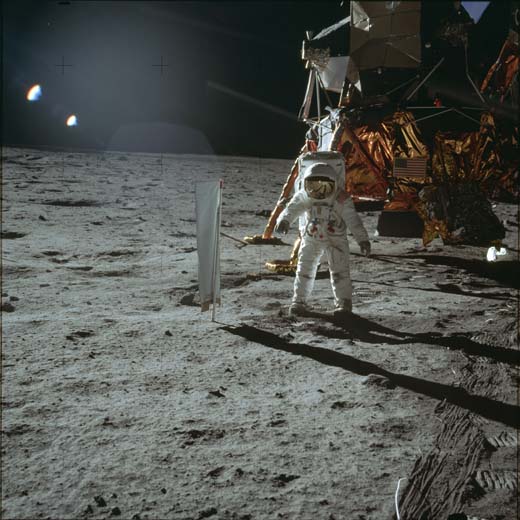 Flights to the Earth orbit are not the ultimate dream of scientists. The transit routes in other galaxies are not yet paved, but about the closest satellite of our planet - the Moon - we cannot already say, "Here no foot may tread!" As you know, it was a small step of man, which became a great one for humanity. But the triumphant astronauts walking on the shore of the Sea of Tranquility was preceded by years of painstaking work of scientists and engineers. Including those, who created special watches for astronauts. Flights to the Earth orbit are not the ultimate dream of scientists. The transit routes in other galaxies are not yet paved, but about the closest satellite of our planet - the Moon - we cannot already say, "Here no foot may tread!" As you know, it was a small step of man, which became a great one for humanity. But the triumphant astronauts walking on the shore of the Sea of Tranquility was preceded by years of painstaking work of scientists and engineers. Including those, who created special watches for astronauts.
The Americans also dreamed of landing on the Moon. The era of space race came in during the Cold War between the USSR and the USA, so it was a matter of principle for each of the parties to beat the opponent. Unable to jump on the Soviet Union in flights of men to the space, the Americans set out a goal to send their astronauts to the Moon as soon as possible.
The program, which would allow scientists to carry out those plans, was named "Apollo." The United States were working on it for many years, since it was a priority for the Americans in space exploration. To get to the Moon first, they spent about $ 25 billion. As a result, the spaceship "Apollo" was designed for that expedition. The similar ones had been already used as transport ships on near-earth orbits to deliver cargo and crews to the U.S. research station "Skylab". In 1969, the time came for the conquest of the Moon.
The ship "Apollo 11" with astronauts Neil Armstrong, Edwin Aldrin and Michael Collins was launched on July 16. It was installed on the booster under the name "Saturn 5". Its height was equal to 109 meters and the total weight of two aircrafts was 2943 tons. On July 19, "Apollo 11" was released to the lunar orbit. And on July 20, 1969, at 11 p.m. 17 minutes 32 seconds the unit successfully landed on the Moon. After six and a half hours Armstrong and Aldrin descended to the surface of the satellite for the first time in human history.
It should be noted that in addition to expensive equipment for researches, the American astronauts were accompanied by watches in this journey. In the USA, the brand “Omega” was awarded with that honor.
The space race between the U.S. and the Soviet Union caused a stir among scientists and engineers not only in the space industry, but also among watchmakers. To find a watch that could withstand the loads and tests during the flights to the Moon, the NASA officials bought ten chronographs of different brands in a store in Houston, keeping in secret the true purpose of their purchase. The selected watches were subjected to imaginable tests. As a result of stringent tests that were conducted for two years four copies dropped out. The companies that created the six remaining ones were offered by NASA to provide 12 watch models for further testing. Such careful selection is quite understandable: in a vacuum the man is protected from strong radiation and extreme temperature drops by his space-suit, but his watch - just by its own case.
After vibration, pressure, heat and cold tests, the watch “Omega Speedmaster”.jpg) was awarded with the title of "astronaut". On March 1, 1965, that watch was officially recommended for the American astronauts performing space missions. “Omega Speedmaster”, in addition to the chronograph function, is supplied with bezel with tachometer scale, date aperture and calendar, hands and hour markers with luminescent coating. The case of 38.8 mm diameter and the strap with hidden clasp, the steel parts of the movement are finished was awarded with the title of "astronaut". On March 1, 1965, that watch was officially recommended for the American astronauts performing space missions. “Omega Speedmaster”, in addition to the chronograph function, is supplied with bezel with tachometer scale, date aperture and calendar, hands and hour markers with luminescent coating. The case of 38.8 mm diameter and the strap with hidden clasp, the steel parts of the movement are finished .jpg) with rhodium. “Omega Speedmaster” has a power reserve of up to 48 hours without winding, it is water resistant at 30 meters. The dial is protected by sapphire crystal with anti-reflective coating. with rhodium. “Omega Speedmaster” has a power reserve of up to 48 hours without winding, it is water resistant at 30 meters. The dial is protected by sapphire crystal with anti-reflective coating.
However, not everybody liked that choice. The union of American businessmen accused NASA of trying to undermine the national industry, because the preference was given to the Swiss brand. The leaders of space agency still upheld the watch “Omega”, although they had to seek support of the U.S. Senate. By the way, before the triumphant landing on the Moon, that chronograph justified hopes of NASA: in 1965, it successfully flew into space during the expedition “Gemini IV”, returning undamaged. And on July 20, 1969, Neil Armstrong with “Omega Speedmaster” on its wrist made a step on lunar soil for the first time. By the way, that watch belonged to Aldrin. Armstrong left his copy in "Apollo 11" - apparently, the board time meter was not as well prepared for space overloads as “Chrono Omega Speedmaster”, which replaced the failed equipment.
Armstrong and Aldrin set a memorial plaque on the Moon. It is engraved: "Here men from the planet Earth first set foot upon the moon. July 1969 A.D. We came in piece for all mankind." Also the astronauts left there the medals that belonged to Yuri Gagarin, Vladimir Komarov, Virgil Grissom, Roger Chaffee and Edward White. For the sake of space exploration, those brave men gave their lives, so they decided to leave the memory of them on the Moon that recently seemed unattainable.
Today, that model “Omega Speedmaster”, with which the American astronauts landed on the Moon, is already out of production. However, this classic series is still completed with new models. Now there is even a female version of “Omega Speedmaster”. In addition to usual features, this watch becomes elegant. “Omega Speedmaster” for women is now available in different colors: with ceramic bezel, dial and strap in white, gray and intriguing purple colors with a piquant detail - bezel ring, finished with 54 diamond. The case of “Omega Speedmaster” is now made of not only stainless steel, but also of 18-carat noble pink gold.
Breitling and Bell & Ross claim to a place in rocket
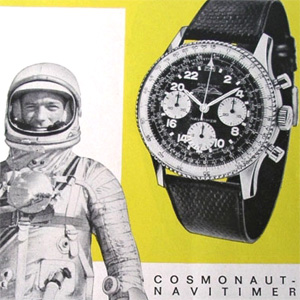 There is a good proverb: There is a good proverb: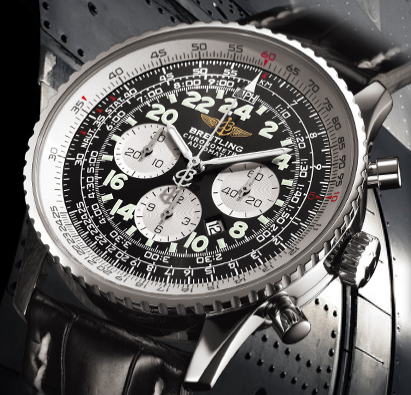 "Nature abhors a vacuum." As it turned out, it is true for the watch manufactories too. While NASA was testing “Omega Speedmaster”, the space exploration forged ahead. And the watch companies were always ready to earn a few points of prestige, especially when it came to space exploration. "Nature abhors a vacuum." As it turned out, it is true for the watch manufactories too. While NASA was testing “Omega Speedmaster”, the space exploration forged ahead. And the watch companies were always ready to earn a few points of prestige, especially when it came to space exploration.
The company “Breitling” was striving to the sky from the very beginning of its existence. In 1915, at the dawn of aeronautics era, that brand produced the first wristwatches specifically for pilots with chronograph function. In the 30s, the company “Breitling” gained the status of an official supplier of British Air Forces. The model “Navitimer” is a successful find of the watchmakers, an ideal symbiosis of time meter and navigation equipment. The masters of Breitling put a circular slide rule in it, with the help of which the pilot could easily calculate the velocity and acceleration of the aircraft, travel time, fuel consumption, and even convert, say, kilometers to miles.
On the basis of “Navitimer”, in 1962, the mechanical chronograph “Cosmonaute” was created. It has a manual winding function, designed for 42 hours of power reserve, a water-resistant case. The main distinguishing feature of “Cosmonaute” is a non-standard markup of the dial. Instead of the usual 12, it is divided into 24 hours. That watch has repeatedly visited the space. The American astronaut Scott Carpenter was the first who tested it. On his wrist the chronograph “Cosmonaute” came aboard the ship "Aurora" and, accordingly, to orbit of the Earth.
The Swiss company “Bell & Ross” also tried itself in the field of space designs.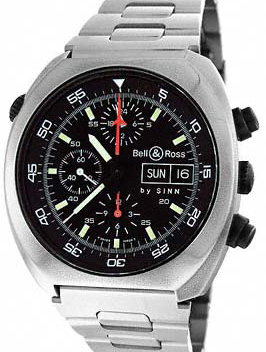 The watchmakers of the manufactory are known for their unique inventions in fine mechanics. They invented, in particular, the telescopic crown (the so-called T-Crown Systerm) and other novelties. With such a rich track record, the masters of “Bell & Ross” started making watches for astronauts. As a result, in 1983, the German conqueror of space Reinhart Ferrer went to the station “Spacelab” with the multi-function chronograph called “Space 1”. In design of that watch the masters of “Bell & Ross” were guided by three fundamental principles necessary for the convenience of the astronauts. These principles include readability, accuracy of time indication and water resistance. In the chronograph “Space 1”, those functions were optimized thanks to the carefully thought-out design. The watchmakers of the manufactory are known for their unique inventions in fine mechanics. They invented, in particular, the telescopic crown (the so-called T-Crown Systerm) and other novelties. With such a rich track record, the masters of “Bell & Ross” started making watches for astronauts. As a result, in 1983, the German conqueror of space Reinhart Ferrer went to the station “Spacelab” with the multi-function chronograph called “Space 1”. In design of that watch the masters of “Bell & Ross” were guided by three fundamental principles necessary for the convenience of the astronauts. These principles include readability, accuracy of time indication and water resistance. In the chronograph “Space 1”, those functions were optimized thanks to the carefully thought-out design.
Reinhart Ferrer’s flight became a sort of powerful advertising campaign for “Bell & Ross”. The watch “Space 1” became so reliable and comfortable that in 1994 they decided to release it to the broad market. The famous chronograph, as well as its modifications, became available for both professional astronauts and ordinary people.
However, NASA still chose the watch of Omega brand. An accident aboard the “Apollo 13" became decisive in the fate of the official watch for the astronauts. When the ship was in space, a balloon with oxygen exploded, and all the electronic equipment on board stopped working. That incident could have very tragic consequences, as a miscalculation of the spacecraft’s safe return time to the Earth's atmosphere was likely to lead to a catastrophe for all the crew. In that difficult situation, the commander of “Apollo 13”, Jim Lowell, made all the necessary calculations with the help of his watch “Omega Speedmaster”, which actually saved the whole crew by returning to the Earth without loss. For that achievement, the Swiss brand was awarded with the prestigious award “Snoopy”. This is the highest award, given by NASA. Then no one doubted that Omega was the watch, which could be safely taken even in space.
The chronograph “Omega Speedmaster” had another achievement too: 44 years after the creation of the watch, the first space tourist - 60-year-old businessman Dennis Tito - chose it for his travel to the space station “Mir”, non-existent today. By the way, the astronauts, who went to space with it, also received “Omega Speedmaster X-33” as a gift.
Travel of Fortis watch to the station "Mir"
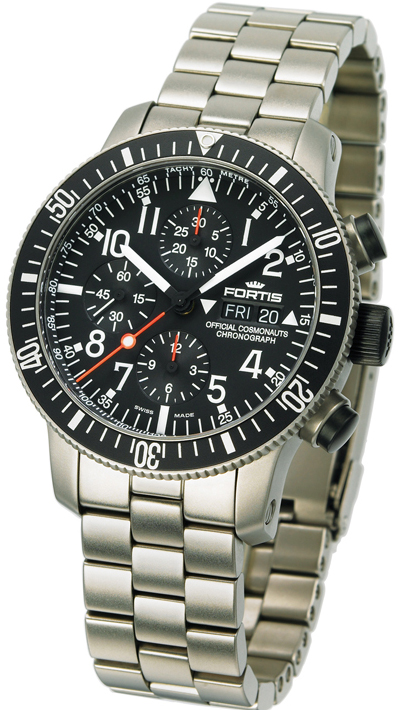 Today, the space race is no longer an end in itself for the superpowers. The representatives from different countries finally realized the more coordinated their work, the greater results in the studies. Globalization has touched the choice of watches for the astronauts too. Today, the space race is no longer an end in itself for the superpowers. The representatives from different countries finally realized the more coordinated their work, the greater results in the studies. Globalization has touched the choice of watches for the astronauts too.
In the 70s - 80s, when the quartz crisis erupted in the watch industry, the company “Fortis” did not only stay afloat, but also continued its designs. During that period an automatic chronograph with automatic winding and alarm functions was created. Another achievement of that time for the company “Fortis” was an automatic watch, designed specifically for working in zero gravity. At the beginning of the 90s, the professionals engaged in space flights became interested in those designs and offered to test that unique watch. The novelty by Fortis was tested by the Soviet Union specialists. In 1992, that watch flew into space on the board of "Proton". In 1995, “Fortis” watch set an absolute world altitude record while flying on an airplane "Mig-25." The final test of the accuracy and reliability was the Russian-German expedition in 1997 to the station "Mir". Presenting itself well in open space, that watch helped the company “Fortis” to get the official status of the Russian Space Agency partner.
Today, watches by Fortis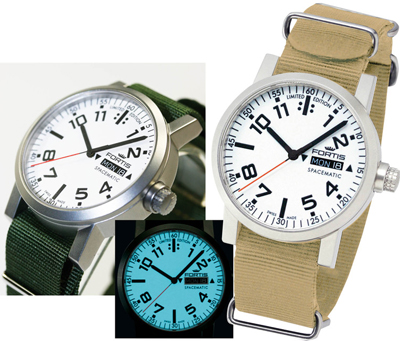 do not lose popularity. They help people to win racing, they are worn by pilots of the fighters "Su-27", by astronauts while going into open space. The “Fortis” watches withstand repeated overloads, exposure to low temperatures, water pressure at great depths. At that the external factors do not prevent them to be accurate. do not lose popularity. They help people to win racing, they are worn by pilots of the fighters "Su-27", by astronauts while going into open space. The “Fortis” watches withstand repeated overloads, exposure to low temperatures, water pressure at great depths. At that the external factors do not prevent them to be accurate.
The company “Fortis” could not ignore such a significant date as the first manned flight into space. In cooperation with the Federal Space Agency, the watchmakers have created a model “Spacematic”. This is a steel watch on leather strap, waterproof at a depth of 200 m and equipped with automatic winding function. However, the latter does not work in zero gravity, but if the owner of this masterpiece from Fortis isn’t going into orbit, the rotor in this situation will be undoubtedly useful. The first hundred copies of “Spacematic” of the planned 300 units were presented to the prominent politicians and leaders of Russian Space Agency. The back case of the watch is engraved with a portrait of the first cosmonaut.
The representatives of “Fortis” presented watches at the 50th anniversary of the first flight to the space by Yuri Gagarin. The festivities on this occasion took place in the House-Museum of Cosmonautics. The cosmonauts, foreign ambassadors and heads of foreign space agencies also received commemorative watches from Fortis as gifts.
Dreams of the Moon by Van Cleef & Arpels
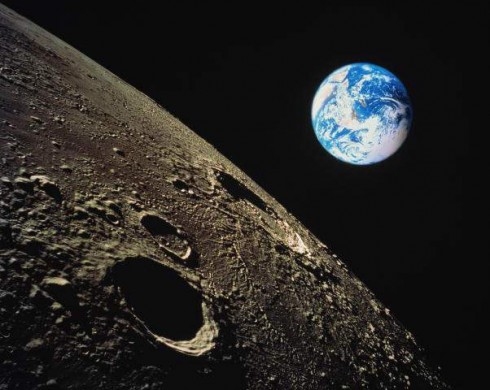 It should be said that they began to study the Moon long before the first flight to it. Most of the craters got the names back in 1650 due to the Italian astronomer Giovanni Battista Riccioli. The names of the lunar landscape parts remind us of the great men of the past: Nicholas Copernicus, Tycho Brahe, Johannes Kepler. Some craters got the names of Greek astronomers - Aristotle, Ptolemy, and Archimedes. After the flight of research satellite "Luna-3", the scientists were able to finally see the downside of the night star, hidden when viewed from the Earth. As pioneers, the Russians gave the discovered details of the lunar landscape the names of Tsiolkovsky, Lomonosov and Popov. The Western scientists were not forgotten either - Edison, Maxwell, Pasteur, Curie and Hertz. In addition, the Moon has a crater named after French science fiction writer Jules Verne, who dreamed of the possibility of flying to the Moon so much. He even invented a special device that would bring people to the surface of a mysterious and attractive satellite of the Earth. It should be said that they began to study the Moon long before the first flight to it. Most of the craters got the names back in 1650 due to the Italian astronomer Giovanni Battista Riccioli. The names of the lunar landscape parts remind us of the great men of the past: Nicholas Copernicus, Tycho Brahe, Johannes Kepler. Some craters got the names of Greek astronomers - Aristotle, Ptolemy, and Archimedes. After the flight of research satellite "Luna-3", the scientists were able to finally see the downside of the night star, hidden when viewed from the Earth. As pioneers, the Russians gave the discovered details of the lunar landscape the names of Tsiolkovsky, Lomonosov and Popov. The Western scientists were not forgotten either - Edison, Maxwell, Pasteur, Curie and Hertz. In addition, the Moon has a crater named after French science fiction writer Jules Verne, who dreamed of the possibility of flying to the Moon so much. He even invented a special device that would bring people to the surface of a mysterious and attractive satellite of the Earth.
In the science fiction novels written in the XIX century, Jules Verne offered to use a special gun to send people to the Moon. In reality, such a device would have been ineffective. The gun spends most of the energy at a shot in the lower atmosphere, where the air resistance is the greatest, since the atmosphere is denser than in the upper layers. As a result, when the piloted vehicle would have to overcome gravity, it wouldn’t have energy any longer.
Although the technology of interstellar travel, offered by Verne, turned out to be unfounded, the way of travel was still very funny. It would be a sin to ignore such a cute idea. Actually, the designers of jewelry house “Van Cleef & Arpels” didn’t pass by it. Inspired by the image of the space gun, they have created two unique watches titled “From the Earth to the Moon” and “From the Earth to the Moon Timeless”.
This is not the first time the masters of the house “Van Cleef & Arpels” address to the works by Jules Verne. However, these models are truly ones of the most unusual in design. The dial of “From the Earth to the Moon” is a kind of space that opens before the eyes of astronauts flying to the Moon. This picture was made by technique of champlevé. The black background of dial is incrusted with images of Jupiter, Earth and Moon of agate, jade and pieces of real meteorite. The design is interesting for the image that is not limited with the case, made of white gold. 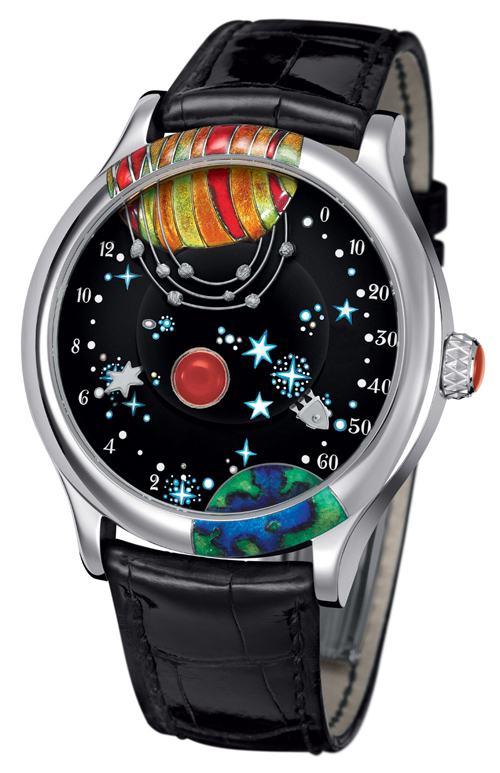 A part of the Earth A part of the Earth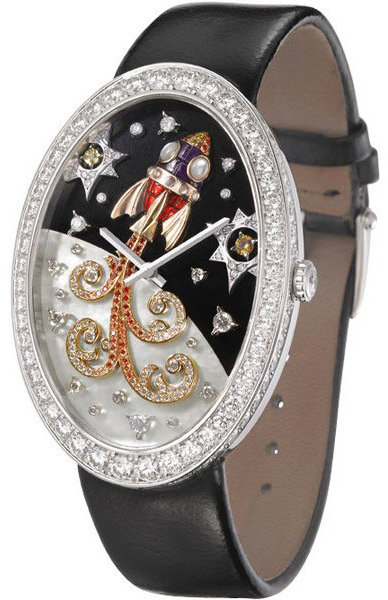 and Jupiter's rings appeared outside the sapphire glass, extending the space for image. The back case of “From the Earth to the Moon” is engraved with an image of space rocket. Its smaller version serves as a minute hand, moving on the scale at the right side of the dial. The hour hand is made in the form of a miniature star. The movement of the watch “From the Earth to the Moon” is a special retrograde module called JLC Caliber 846 of manual winding, designed specifically for this model. The watch “From the Earth to the Moon” is released in a single copy. This unique model is created by the masters of the house “Van Cleef & Arpels” especially for the charity auction “Only Watch 2011”. and Jupiter's rings appeared outside the sapphire glass, extending the space for image. The back case of “From the Earth to the Moon” is engraved with an image of space rocket. Its smaller version serves as a minute hand, moving on the scale at the right side of the dial. The hour hand is made in the form of a miniature star. The movement of the watch “From the Earth to the Moon” is a special retrograde module called JLC Caliber 846 of manual winding, designed specifically for this model. The watch “From the Earth to the Moon” is released in a single copy. This unique model is created by the masters of the house “Van Cleef & Arpels” especially for the charity auction “Only Watch 2011”.
The model “From the Earth to the Moon Timeless” is a fruit of the work of both watchmakers and jewelers. This watch is not too impressive in size - only 30 mm in length and 24 in width. However, such a tiny dial is provided by jewelers with a unique image. Its upper part is a space of black enamel and stars of diamonds and rare yellow sapphires, the bottom is decorated with natural mother-of-pearl. The central part of the dial has a rocket made of white gold and enamel, flying toward the Moon. It is encrusted with diamonds, spinels, manganese-aluminium garnet, citrine, garnet, and moonstone. By the way, the oval case of “From the Earth to the Moon Timeless” is also decorated with precious stones. The bezel is incrusted with a track of diamonds, carefully selected for purity and size parameters.
Either of these two options of fantasy journeys to the Moon is ideal for those, who still believe in fairy tales and who are able to appreciate the romantic images created by Jules Verne.
More pragmatic people can easily find watches, similar to those used by astronauts. Also, the watch manufactories produce memorial series, devoted to various important dates in the history of space exploration. Typically, these models are issued in limited editions. It is not easy to buy such watches, and they cost correspondingly to their status of collectible models, more expensive than their traditional prototypes. For example, the legendary “Omega Speedmaster” in 1961 cost only 82 dollars 50 cents. Today you can buy it or Breitling, Fortis or "Shturmanskie", but for much more. And who knows, maybe even the space tourism will become more widespread, and these watches will be used for their intended purpose.
|


